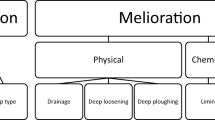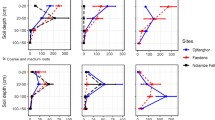Abstract
Tensiometer measurements were carried out on a typic Paleudult in the humid forest zone of south eastern Nigeria in an alley cropping trial using fertilized and unfertilizedDactyladenia (Acioa) barteri andSenna (Cassia) siamea as hedgerow trees and a no-tree control. The interrow space of alley cropped and no-tree control plots were planted to maize/cassava intercrop. Water withdrawal during short dry spells and the dry season occurred fastest in the no-tree control plot and resembled the pattern in the adjacentS. siamea alley cropping. Previous root investigations showed that the whole no-tree control plot was within the range of root propagation of the adjacent hedgerow trees. Installation of a 70 cm deep root barrier led to a retarded water withdrawal in unfertilized no-tree control plots to a depth of 150 cm. In fertilized no-tree control this retardation occurred to a depth of 110 cm, while at 130 and 150 cm water withdrawal with root barriers was faster than without barriers. Results indicate thatS. siamea depleted water resources in the no-tree control plot and shortened the growing season of cassava. Restricting roots to the assigned plot size can reduce competition for water in adjacent plots even in layers below the depth of the barrier but can also induce compensative water withdrawal from layers which were not necessarily affected by the barrier. It appears that currently no standard methodology is available to conduct agroforestry trials without the risk of invalidation through root interference. Methods to determine minimum plot size in order to reduce the risk of invalidation and misinterpretation of results are suggested.
Similar content being viewed by others

References
De Willingen P and Van Noordwijk M (1989) Rooting depth, synchronization, synlocalization and N-use efficiency under humid tropical conditions. In: Van der Heide, ed, Nutrient Management for Food Crop Production in Tropical Farming Systems, pp 145–156. Haren, The Netherlands
Gichuru M and Kang BT (1990) Potential woody species for alley cropping on acid soils: In: More E, ed, Agroforestry Land-Use Systems. Proceedings of a Special Session of American Society of Agronomy Annual Meeting, 28–29 November, 1988. Anaheim, CA, USA
Hauser S (1990) Water and nutrient dynamics under alley cropping versus monocropping in the humid-subhumid transition zone. Transaction 14. ICSS, Vol VI, pp 204–209. Kyoto, Japan
Hauser S (1993) Root distribution ofDactyladenia (Acioa) barteri andSenna (Cassia) siamea in alley cropping on ultisol. I. Implication for field experimentation. Agroforestry Systems 24: 111–121.
IITA (1984) Research Highlights of 1983, pp 22–27. International Institute of Tropical Agriculture (IITA), Ibadan, Nigeria
IITA (1990) Annual Report for 1989 Resource and Crop Management Program, pp 17–18. International Institute of Tropical Agriculture, Ibadan, Nigeria
Kang BT and Wilson GF (1987) The development of alley cropping as a promising agroforestry technology. In: Steppler HA and Nair PKR, eds, Agroforestry: A Decade of Development, pp 227–243. ICRAF, Nairobi, Kenya
Kang BT, Wilson GF and Lawson TL (1984) Alley cropping a stable alternative to shifting cultivation. International Institute of Tropical Agriculture (IITA), Ibadan, Nigeria
Kang BT, Grimme H and Lawson TL (1985) Alley cropping sequentially cropped maize and cowpea with Leucaena on a sandy soil in southern Nigeria. Plant and Soil 85: 267–277
Kang BT, Reynolds L and Atta-Krah AN (1990) Alley farming. Adv Agron 43: 315–359
Lal R (1991) Myths and scientific realities of agroforestry as a strategy for sustainable management for soils in the tropics. Adv Soil Sci 15: 91–137
Singh RP, Ong CK and Saharan N (1989) Above and below ground interactions in alley-cropping in semi arid India. Agroforestry Systems 9: 259–274
Wood PJ (1980) Principles of species selection for agroforestry In: MacDicken KG and Vergara NT, eds, Agroforestry: Classification and Management, pp 290–309. John Wiley & Sons, New York
Author information
Authors and Affiliations
Rights and permissions
About this article
Cite this article
Hauser, S., Gichuru, M.P. Root distribution ofDactyladenia (Acioa) barteri andSenna (Cassia) Siamea in alley cropping on Ultisol. II. Impact on water regime and consequences for experimental design. Agroforest Syst 26, 9–21 (1994). https://doi.org/10.1007/BF00705149
Issue Date:
DOI: https://doi.org/10.1007/BF00705149



